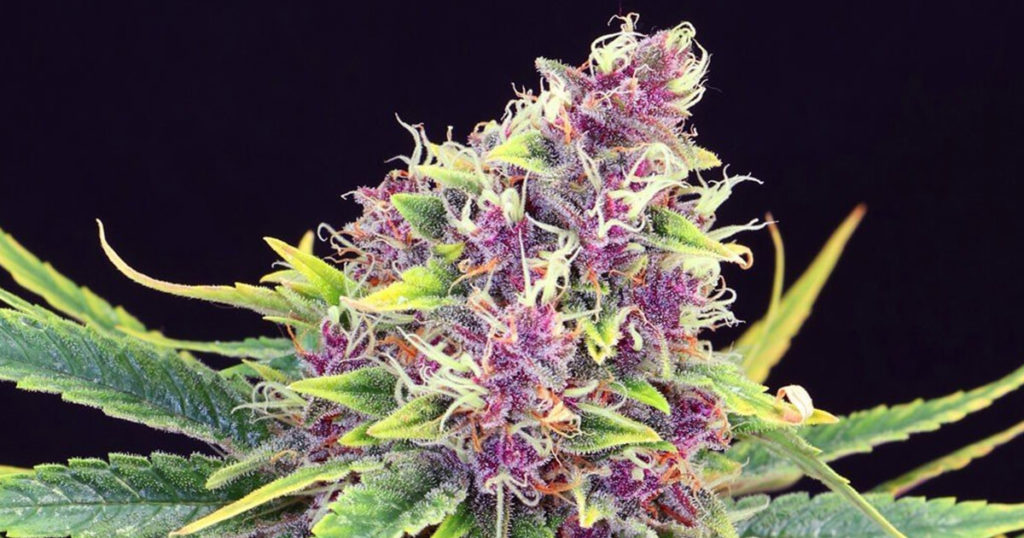Purple Kush- There are so many strains of cannabis out there, and new ones pop up almost every day. Whether you’re a fan of Sativa, or Indica, or prefer a nice hybrid, there’s definitely something for every pot smoker out there. Sativa strains are generally associated with head highs. They can reduce stress and anxiety while promoting focus and creativity. Indica, on the other hand, gives smokers more of a body high. It can help reduce pain and nausea and stimulate your appetite. Its relaxing effects also help reduce insomnia. Hybrid strains are, obviously, a combination of the two, and so their effects are also a mixture.
One of the most famous strains of Indica is Purple Kush. It’s one of those names that even non-smokers have heard. But what’s the story behind the weed in your after-work or nighttime joint or bowl? Read on to find out the origins of Purple Kush and how you can grow it if you wanted to.
That gorgeously colored, pure Indica strain that High Times named one of the Top Ten Kush Strains in 2016 was originally created in California, in a neighborhood in Oakland often called Oaksterdam. Purple Kush was created by crossbreeding Hindu Kush and Purple Afghani, but it’s actually the climate in which it’s grown that gives Purple Kush its color.
What Is Purple Kush?
As mentioned earlier, Purple Kush is a strain of pot created by crossbreeding Purple Afghani and Hindu Kush. Its genetics are 100% Indica, and its THC levels vary anywhere from 17% to 27%, so it makes you incredibly relaxed while also giving you that fun, giggly feeling. It’s often used to help fight depression, insomnia, and anxiety. This strain also tends to have a unique flavor that can sometimes taste like grapes or candy. Purple Kush is the perfect smoke to calm down and just relax after a stressful day at work, but due to its effects being those of “dopey contentment,” according to Wikileaf, it’s probably best used at night time, unlike Sativa strains that can be smoked whenever.
Its color, of course, is what gives Purple Kush its name. Known for its brightly colored buds coming in beautiful reds, pinks, and purples, these striking colors can range from darks to lights, surrounded by dark to even neon green leaves.
The amazing colors of this strain of kush come from the plant’s pigments, called anthocyanins. Just as the breaking down of chlorophyll in the colder fall weather turns the leaves of trees from greens to oranges, reds, and yellows, the cold also breaks down the chlorophyll in Purple Kush plants, allowing for the anthocyanins to shine thought, creating those stunning purple, red, and pink colors of the buds.
How Do I Grow It?
Despite popular belief that depriving your plants of oxygen or increasing their intake of nitrogen will turn your buds purple, this is not actually the case. In order to get purple buds, you need to choose a strain that’s high in anthocyanins. Other strains with purple or blue hues that are high in anthocyanins are Purple Haze, Granddaddy Purple, and Blue Mystic.
The most important aspect of the growing process to get the brightest colors from your Purple Kush is regulating the proper temperatures. Since anthocyanins are only able to shine through once the chlorophyll begins to deteriorate, you’re going to need to lower the temperature at night during your plant’s flowering stage, if you’re growing indoors. The temp should be below 50 degrees Fahrenheit at some points, but remember that keeping your plants that cold for so long can also be harmful to them. So be sure to keep a close eye on them. If you’ve met all the optimal conditions for your plants, the buds will begin to turn purple around two weeks before they’re ready to harvest.
Though Purple Kush tends to do better in soil, they can also do well with a proper hydroponics system. This versatile strain can also be grown either indoors or outdoors – however, because it’s such a short, bushy plant, it does tend to do better indoors. If growing indoors, the humidity needs to be kept at a minimum, and if outdoors, exposure to humidity and the elements – like rain – need to be limited as well. Purple Kush is especially vulnerable to rain, so keep that in mind when deciding where you want to grow your plants.
Hydroponics Systems For Your Purple Kush
If you opt to grow your plants using a hydroponics system, there are a few things to keep in mind. The first thing to consider is what kind of system you want to use. Purple Kush tends to do exceptionally well with both the Wick system and Deep Water Culture. The Wick system, for newbie growers, is when you connect your pots using a large wick that will then be laid into a reservoir that contains at least a week’s worth of water and nutrients. Deep Water Culture systems involve suspending your plants’ roots into a nutrient solution with high oxygen content.
Another important aspect of growing with a hydroponics system is ensuring your plants are receiving the right amounts of nutrients. The perfect mix of nitrogen, phosphorus, potassium, sulfur, copper, zinc, boron, and magnesium will have your Purple Kush growing like, well, a weed. These nutrients can be easily purchased in either solution or powder forms.
These tips should be enough to get you started on growing your very own Purple Kush, but if you’re looking for some more in-depth information, check out Beard Bros Pharms’ articles called Grow Your Own Cannabis. Happy growing, fellow stoners!



















